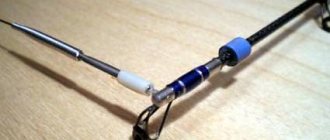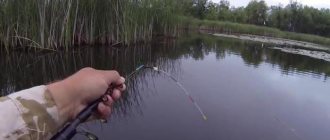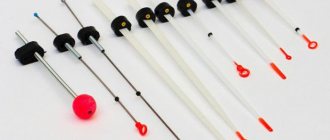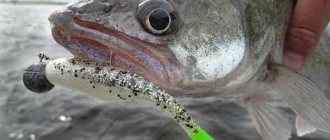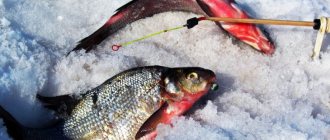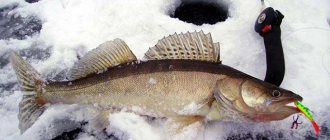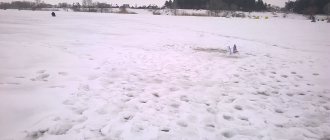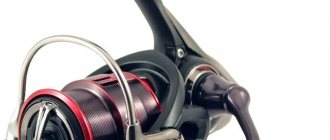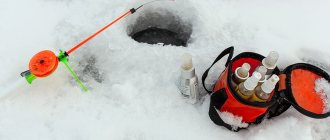In small reed creeks, you can start the open water season by catching crucian carp in the spring with a jig. In some places, especially in the south, you can catch silverfish with a side nod as soon as the ice melts from the reservoirs. With further warming, the bite will only intensify. Catching crucian carp in the spring with a nod allows you to search shallow water points completely overgrown with reeds that are inaccessible to a regular fishing rod, donkey or feeder.
In summer, this method also works among thickets and water lilies, from the shore, in a wade or from a boat. In this article, we will look at how to catch crucian carp with a side nod in open water, what gear and bait to use for this.
Spring crucian carp on a jig in open water
In the middle zone, crucian carp become active in the spring in April-May. In the south, you can catch it in the warm spring in March; the main period of activation begins in mid-April - when the air temperature during the day averages +15 degrees, and at night – about 8-10. The silver glutton is finally activated when the water temperature exceeds 12 degrees.
At this time, it finally moves from deep places to shallow overgrown pools, and migratory flocks rise up the tributaries. At a water temperature of + 16, spawning begins for crucian carp and continues until June. At the same time, the bite continues - individuals that have already spawned or have not yet started spawning are caught.
Fishing for crucian carp on the side nod in early spring is successful in those places where the crucian carp stays in overgrown shallow waters immediately after the ice melts. Usually these are coastal overgrown zones of reservoirs, rivers and shallow warm waters in the south of Russia and Ukraine.
Fishing for crucian carp in the spring with a jig in such creeks at this time is not yet as active as in warm water, but with a certain amount of endurance and constant searching, you can fish out a bast fish weighing one and a half kg from the reeds. Along with the silverfish, roach, rudd and sometimes carp are caught on the hook. In the middle zone, the active phase of crucian carp fishing begins closer to May, with the decline of the flood. More information about catching crucian carp in the spring:
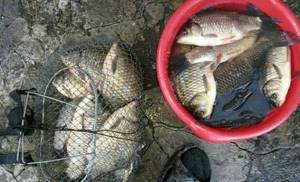
With the final warming, the crucian bite develops into a pre-spawning feast. Nodding tackle allows you to fish the most inaccessible places - continuous thickets and small windows among them. Such points are the most promising places. Natural signals are the beginning of active growth of grass on the shore, reeds in the water, young leaves on the trees. Along with crucian carp in such bays, it is quite possible to catch carp with a jig.
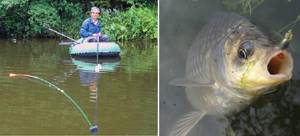
Side nod to crucian carp in summer
With the onset of heat, the silvery fat fish moves deeper in clean reservoirs. But if there are thickets, the crucian carp will live in them throughout the entire season. Wherever you can crawl up or swim in a boat, go into wades, you can fish with a summer fishing rod on a side nod. The advantages of this method are obvious:
- With a fishing rod for crucian carp and jig in the summer, you can go around many points on foot or by boat. The search method works. The fisherman does not hatch fish using bait, but looks for cool spots on his own.
- In the reeds the fish are not so shy. You don’t have to go too thin with the equipment. On the contrary, in order to quickly pull fish out of the thickets, fairly thick fishing lines, 0.16-0.25 mm in diameter, are used.
- Sometimes the crucian carp does not take the stationary bait. And with a side nod and playing with a jig, it’s great for catching.

If the place is known or there is information that there is definitely crucian carp in these thickets, you can bait the window and wait, catching it one by one with a float or a side nod, selecting various baits, dips and bait methods. The choice of fishing tactics for crucian carp depends on the season. Catching crucian carp with a jig in the summer using a side nod can be as active as with a spinning rod.
In early spring, the search method works better, since the fish mostly stands still, and sometimes it is useless to sit on bait. In warm water, you can feed a point, especially if you know the composition that works for crucian carp for this reservoir, and fish in one place.
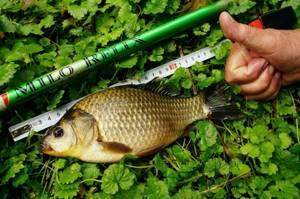
How to fish with a jig
A jig is a hunting projectile for hunting in underwater thickets. The search for promising places can occur in both standing and flowing reservoirs with an intense degree of underwater thicket formations. As a rule, the depths of such reservoirs rarely exceed 3–5 meters, but the locations of free windows and openings can be near the coastlines and at distant distances from them. For certain hunting conditions, either a swimming device in the form of a boat or an inflatable raft, or the use of waterproof overalls like waders or ordinary high waders can be used.
From the shore, the supply of jigs to the trophy extraction points is carried out by selecting effective lengths of gear. The jig season in open water is considered to be all summer and autumn months, right up to the withering of the aquatic vegetation, at the beginning of which the fish move to deeper water areas of reservoirs. The prey items are all white fish, perch and ruff. The most popular fishing among summer jigs is crucian carp, bream, roach and perch. We will discuss some fishing features in more detail in subsequent sections of the article.
Features of fishing from a boat
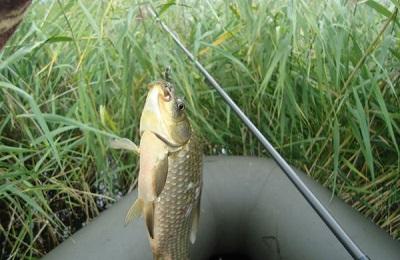
The boat allows you to approach a specific bait supply point, and on a short length of the form it is more effective to play the bait and more clearly see the moment of biting. Approaching a clean window, the bait is lowered to the bottom and after a couple of seconds they begin to move with a rise of 5–7 centimeters and lowering back and tapping the weight on the ground. The operation according to this principle is repeated five times. If there is no bite, change the horizon to half the water level and make short throws. After the same five techniques, they change the location, being careful when moving and anchoring the boat. They return to the fishing point no earlier than an hour later, repeating the algorithm of actions. A landing net with a long handle is taken into the boat, which helps to pick up the caught trophy without bringing it close to the side of the boat, thereby not scaring the rest of the fish and without exposing the equipment to entanglement in algae.
How to fish with a jig from the shore in summer
In summer, fishing with a jig from the shore can be carried out both in open and accessible windows and gaps, and near the walls of the coastal reed thicket. For the most part, blind equipment is used. Fishing carried out in a wade is effective. This way the fish is less frightened without noticing the fisherman. Having determined the fishing location, the bait is brought to the bottom and, after a short pause, pulled along the ground with a fishing rod, making a muddy path. After waiting a couple of seconds, the jig is raised about five centimeters from the bottom and an intense animation begins, which is carried out in the range of 10–15 cm vertically with intermittent amplitudes of throws.
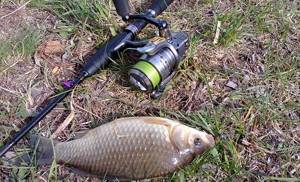
Having not felt a bite for ten seconds, they change the horizon of the game, raising the bait by half a meter and repeat the actions, thus bringing the bait to the very surface. Having fished the entire horizon to no avail, they change place, returning no earlier than an hour for the next attempt. Before fishing, they walk along the expected trajectory of the fishing trail, choosing promising windows in advance. At successful openings, stops are made longer, repeating the game cycles more often than in unsuccessful empty places.
How to fish in still water
In still waters, more sensitive equipment with a light weight jig and a thin main line is used. Current forces do not affect the play of the bait and soft side nods from a plastic bottle most accurately signal even small bites. The load is delivered to a certain point without fear of its displacement through traction, and the playing technique is carried out purely along the vertical trajectory of lifting the rod without retracting the quiver tip. The animation itself is done without aggression, with smooth but distinct movements. In stagnant waters, food objects behave calmly, without resisting the flowing water, therefore such movements of artificial baits also do not arouse suspicion in the fish, which ensures overall success and an increase in bites.
Fishing on the current
Fishing with a jig in the summer on the current requires the use of heavy fishing tools, which is due to the resulting errors in feeding baits and, accordingly, further snags on nearby algae. When lowering the jig into a free window, they take into account the possible displacement of the load with the flow and subsequently carry out the game, constantly moving the rod opposite the movement of the flow. In such conditions they play with bait more energetically, but briefly, trying to maintain small amplitudes of movement, as if attempting to fight the insect with flowing water. The jig is not carried out vertically, but at an angle towards the current. For signaling devices, metal nods are used, which are more rigid in structure and do not reflect the transmission of false signals from the natural forces of the current in the reservoir. Thicker lines are used. These factors reduce the sensitivity of the equipment, but increase the reliability, which is required due to frequent hooks and more stubborn struggle of the fish being caught.
Side nod fishing tactics
For early spring crucian carp fishing with a jig, it is important to take into account points that directly affect performance.
- In early spring, in clear water, we use thin fishing lines, 0.14-0.16 mm. In very remote thickets it is difficult to fish with a thin line - there are continuous hooks. Therefore, we choose thinner reeds, windows, the border of clear water and thickets.
- Accordingly, on thin equipment we use small jigs, 0.5-2 grams, with small hooks, black or brown. Shiny and bright baits can now only scare the fish.
- For a light load, we also select a more flexible nod, otherwise we will not see careful bites from passive fish.
- The main tactical method is search. We walk along the shore, in wads, waders, the lower part of the OZK, or on a boat through shallow creeks with last year’s dead wood, along holes near the shore. At the same time, it is important not to make noise - not to splash the oars, not to stomp, not to stir up the water too much if we are wading. If we are wandering through the water, we walk carefully, 2-3 steps at a time. If you managed to catch fish in one of the places, you need to return to this point after 30-40 minutes and try again.
- Playing with a jig is slow, gentle tapping on the bottom, slow rises of 10 cm with pauses, or natural lowering of the bait.
- The baits are small, bloodworms, maggots, small worms. Bloodworms work best in early spring on the side nod. The mosquito has not yet flown out, and its larvae are the main food supply for fish in overgrown backwaters.
- Due to thin rigs and light jigs, it is difficult to work in the wind. Therefore, in early spring we choose quiet, sunny days for fishing. In summer, a slight breeze is, on the contrary, an ally. Firstly, the fish are calmer when there are ripples on the water, it is easier to approach them by boat and not frighten them. Secondly, in the summer jigs use larger, 3-7 grams, and more powerful nods. For such equipment, a light breeze is not a problem. In addition to crucian carp, in the spring in the thickets any fish can bite on the side nod - roach, rudd, and with warming - tench, carp, carp. Read more in an article about fishing with a side nod in the spring.
- For crucian carp in summer you need a larger jig. In warm water, the silverfish actively resists, and in the reeds it is not afraid of thicker fishing lines and large baits. You won’t be able to catch a large crucian carp from the reeds with a thin line in the summer. The power of the rig should allow you to rip out a fat silver fish that has sat on the hook immediately to the surface of the water and drag it towards you on top of the grass in the water.
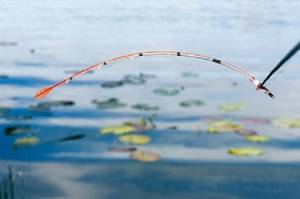
In the summer, on an unfamiliar body of water, you can also start with a search, and feed already where there were bites. In water areas where there are a lot of fish and the terrain is approximately monotonous (hectares of monotonous thickets and even depth), we select a window or clearing and immediately feed them.
Naturally, in large bodies of water it is only possible to fish from a boat. You cannot approach the reed floodplains from the shore or by wading. Sometimes you need to prepare the window yourself by tearing through some of the grass to make casting easier.
The main task is to enable competition for food among crucian carp. Usually in the thickets, quite sparsely in the summer, there are a lot of fish, which gradually begin to gather at the point with bait. When there are a lot of fish in one place, the bait is thrown in a little at a time, and several crucian carp look at the abandoned bait at once. At the same time, they will try to grab the jig faster in order to get ahead of their brothers.
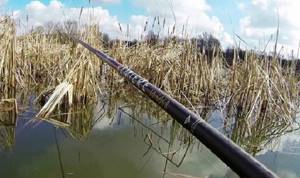
A moving jig in the reeds often works better than a float, since in addition to the smell, the crucian carp determines its location by the vibrations of the lateral line, and quickly comes out of the thickets to the bait. If everything is done correctly, you can catch more fish in an hour than in a whole day in early spring. The choice of tactics, searching or feeding at a point, depends on the characteristics of the reservoir. It’s worth trying both options in the summer and sticking with the one that works better. An article about side nod fishing.
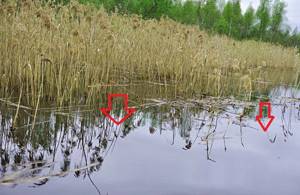
Finding fish and fishing spots
We look for crucian carp in early spring in any available shallow overgrown places, even with depths of 50-70 cm.
- Shallow bays with reeds.
- The entire coastal zone of small and medium-sized rivers with the remains of last year’s reeds, pondweed, and cattails.
- Small oxbows and stakes, flooded thickets of willow and willow, flooded meadows.
- Overgrown shallow spits protruding into the main water area (you can wade along them quite far).
- In places where many fishermen fish in this way, walkways are laid on reed bays from the remains of lumber, old boards and pickets. You can fish directly from them, throwing a fishing rod into windows or clearings. A variety of bridges, dams, and piers are also suitable for fishing.
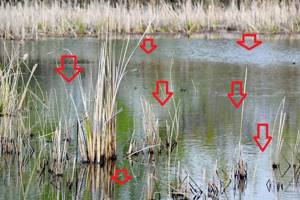
In summer, it is more convenient to use a side nod from a boat - a much larger number of promising places open up with depths of up to 2-3 meters. The best summer places for crucian carp and jigs are thickets of water lilies, egg capsules and water lilies. Under them there is usually just from 1.5 to 2.5 meters of water. In summer, heavier jigs can be used to fish not only in still water, but also in weak currents.
The boat provides an advantage if the feeding method does not work. From on board you can examine many more promising points. Catching crucian carp with a jig in the summer also works in the heat, in the middle of the day. In open areas near the shore it usually bites only in the morning and at sunset. However, crucian carp swim in water lilies in relative coolness, in the shade of leaves, and if you find a school, you can hit the fish at lunchtime, even in the heat.
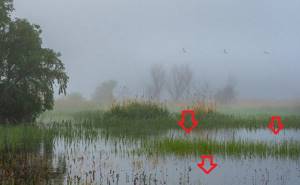
Advantages of jig fishing in summer
The device of this bait is simple. This is a small hook, which is soldered with a fore-end into the tip of any heavy metal - tin, lead.
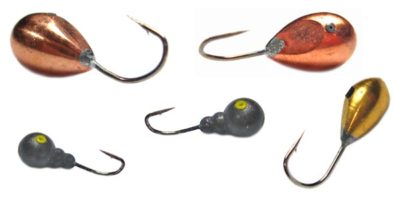
The differences between these winter and summer baits are determined by the life of the fish at different times of the year. In the summer, the fish are more active and the bite is more constant and faster. Even in the summer, fish come out that in winter do not show interest in the bait. For example, crucian carp and tench.
The standard summer jig has different sizes compared to the winter jig, as well as a different color. For example, it is used to catch crucian carp, resembling a dung fly pupa.
Fishing with a jig from the shore in the summer is a creative endeavor. At this time, the fish have enough food and the fisherman has to come up with different ways to move the bait in order for a bite to occur. This process is more productive in extreme heat, when the fish hides in thickets of grass.
Fishing rod with a side nod for crucian carp
The fishing rod needs to be held in your hand at all times, so it should be light and comfortable. The nod is selected according to the weight of the jig - purchased or homemade. For coastal fishing, you can take regular carbon fiber telescopic rods up to 7 meters long. When choosing, you need to take the stick in your hand and shake it, try to reproduce the movements of the game with a jig.
You need to choose a rod that is light but stiff. Noodle sticks will not work - the tip will swing too much when playing. The best option is a lightweight carbon or composite telescope, rigid as a rapier, 5-6 meters long (from a boat - 4-5 meters). Both rods with rings and reel seats for fishing rods with reels, as well as fly rods with connectors for blind rigs, are suitable.
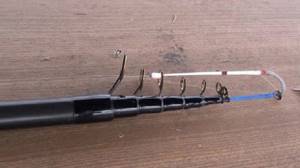
Some fishermen use long poles, up to 8 meters, without rings, and casting and retrieving are carried out by extending and reassembling the telescope arms. However, this method of fishing with a nod in open water is suitable for fishing in clean places, for example, for roach.
In 99% of cases, crucian carp needs to be caught in the thickets, so the jig needs to be lowered from above directly into the gap among the reeds. This is inconvenient to do with long rods over 6 meters. Read more about side nod rods.
Equipment
For summer jigs for crucian carp, you can use three types of equipment:
- Blind - on short fly rods. In this case, the depth at the fishing spot should be slightly less than the length of the rod. For example, a fishing rod is 4 meters long, and the length of line on it to the jig is 3 meters. This will allow you to fish at a depth of approximately 2 meters, keeping the rod tip 1 m above the surface of the water. It makes sense to assemble such a fishing rod for specific fishing conditions in one place.
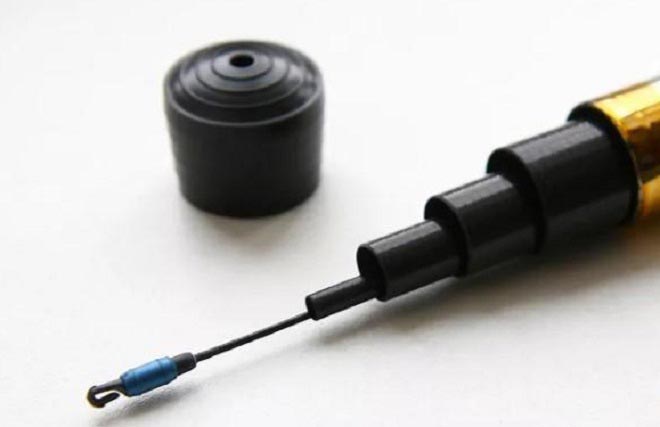
- A more universal option is on a fishing rod for Bolognese tackle, with rings and a reel seat. The fishing line is wound onto a reel, which is attached to the fishing rod. At the same time, at the beginning of fishing, a working descent is set for each specific fishing spot, depending on the depth. Excess line is wound onto the reel. This option can also be done on a fly fishing rod without rings. In this case, a small, lightweight reel is attached to the upper half of the rod, sliding directly onto it through a hole in the middle. These first two options are “crutches”, in the absence of a normal light rod with rings.
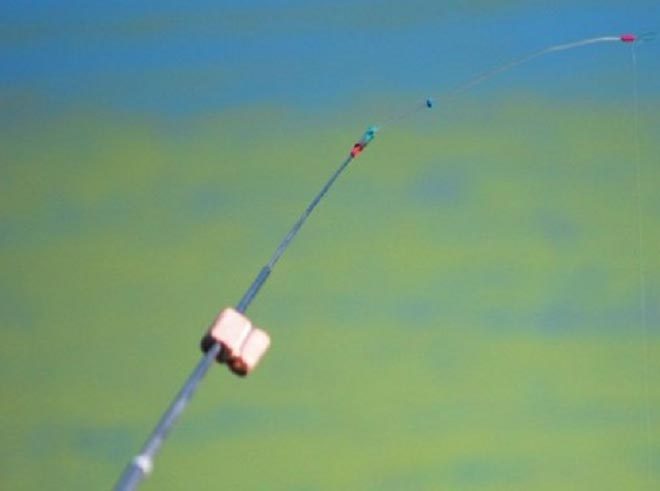
Adjustable reel (top) - The most popular and universal rig for jigs for crucian carp in spring and summer is a fishing rod with a plastic inertial reel and guide rings. This allows you to use the search method of fishing, since you can quickly set the working descent depending on the depth at the fishing point. At the same time, the reel is a small, lightweight plastic, the most common and cheap. Fishing with a reel in the reeds is not carried out - the fish immediately pulls out at the angler. In addition, such a reel hardly weighs down the tackle.
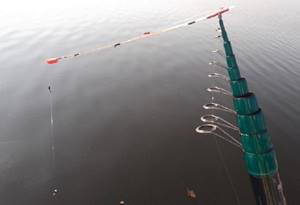
- For fishing in early spring, we wind a monofilament line with a cross-section of about 14-0.16 mm on a reel, under light jigs. In regions where there are a lot of crucian carp, both large and not very shy, you can immediately reel in the summer version - 0.2-0.25, for heavy jigs and pulling fish out of the reeds.
- If you are fishing in water lilies, you can use thinner ones, 0.18-0.2 mm. The option of a thick 0.25 line with a 0.14 leash is not suitable for spring and light jigs.
- A light jig does not play well on a thick base. It’s better to rewind the monofilament - you don’t need a lot of it anyway, unless you have to fish for carp.
- To catch particularly large crucian carp or crucian carp, experienced jig fishers use a braided cord of 0.1-0.12 mm with a breaking load of 7-10 kg to quickly pull the fish out of the thickets. Working with a cord is more difficult - it is easier to tangle, however, with a certain skill, such tackle allows you to fish out larger fish from the grass. Soft water lilies are simply sawed or cut off by a thin cord if the carp gets entangled in them.
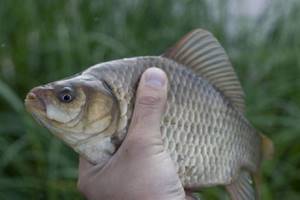
Nod
For fishing for crucian carp with a jig in open water, a more powerful nod is required than in winter, since the baits used are heavier. In addition, you need to think about its visibility from a distance corresponding to the length of the rod. When assembling the tackle, the nod is adjusted to the weight of the jig so that when loaded it bends by 5-7 centimeters.
The length of such a guard is 20-30 cm. You can place it on the fishing rod as usual, parallel to the fishing rod. However, a much more convenient option is a side gatehouse. For right-handers - on the left, for left-handers - on the right, it’s easier to see and it’s more convenient to observe the bite. The shorter the rod, the lighter the jigs and flexible nods can be used, provided there is no wind.
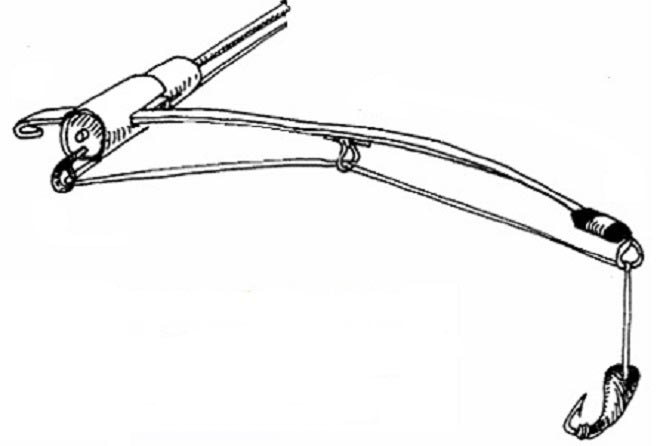
The side guard consists of a flexible form, a connector for attaching to the fishing rod, pass-through rings and a visual point for visibility (bead, flag, multi-colored heat-shrinkable tube). Sometimes such nods can be found in fishing stores.
Powerful lavsan guards for winter balancers are also suitable - an almost ready-made option, all that remains is to adapt them to the rod through an angular connector (in a homemade version - a piece of spring or wire attached at an angle of 90 degrees to the rod). When making a homemade connector, there is no need to make it heavy, otherwise parasitic vibrations of the fishing rod tip will be created when playing.
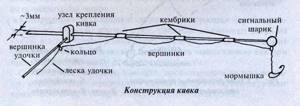
More often, fishermen make side guards with their own hands. To create a form, you can use various flexible materials:
- Plastic bottles;
- Construction tape;
- Clock spring;
- Lavsan;
- Plastic clamps;
- Lint from synthetic brooms;
- X-ray film.
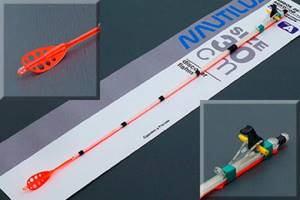
Shop nod
It makes no difference how exactly the side guard is technically implemented - the main thing is that it produces correct play with the jig, passes the line without obstacles, and is securely attached to the rod. An article about making summer side nods.
Jig with float
Often, crucian carp fishermen use jigs in the equipment of conventional float rods. Some people just think it’s better this way. In other cases, it actually works better. Maybe the silverfish is interested in the sparkle of the jig, but the game is not needed, or simply the position at the bottom of the bait on the jig attracts him more than on the hook.
- The main advantage of this kind of fishing is for those who like not very active fishing, but rather calm contemplation of the float. In this case, you can sometimes weakly play with the bait, then lower it to the bottom again.
- Often it is after such provocations that a bite follows. There is no work with a nod in this equipment - so you can use longer rods, 7-8 meters.
- The bite is still detected using the float. Casting is the same as with a jig.
- The fishing rod is not cast - the rig is lowered carefully and precisely from above into the clearing the length of the fishing rod.
Article about spring fishing with a float rod for crucian carp
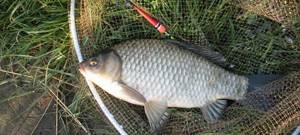
How to do a side nod
Making a side nod for summer fishing with your own hands is not as easy as it seems at first glance, however, most of the really working nods are just homemade. To make them, ribbons from old alarm clocks and other devices that have a carbon steel ribbon in their winding mechanisms can be used.
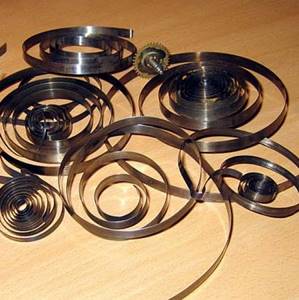
To straighten such a spring, it must be preheated, but here it is important not to overheat it, otherwise the workpiece will have to be scrapped. By the way, these same springs are used in the manufacture of vents.
The side nod has a cone-shaped shape. Its width near the signaling device is about 0.2 mm to 0.6 mm, at the base the width can reach up to 4 mm, it all depends on the load-carrying capacity of the nod. The length also varies from 32 cm to 38 cm. It depends on the length of the rod, the weight of the jig and the fishing conditions, which include the strength of the wind and current, as well as the size of the fish you are going to catch. The processing of the plate is carried out using sandpaper, and it must be said that this is a very labor-intensive task.
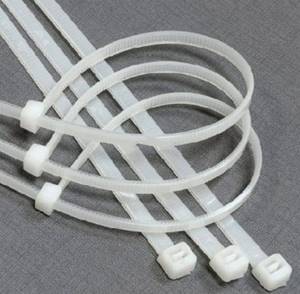
It is much easier to make a side nod for summer fishing with your own hands from a plastic clamp, that is, from a tie. This will only take a few minutes. To make such a nod, you do not need to have skills in working with metal or special tools, and every angler can make it.
Side nod fishing technique
Some technical features and useful tips for catching crucian carp with a side nod from the shore and boat in open water:
- We experiment with the game - it is important to find the movements to which the crucian reacts. This usually involves relatively slow rocking 3-10 cm from the bottom, slow lowering or tapping to create turbidity.
- Crucian carp is not a perch, so we don’t constantly pull the jig. The game needs to be measured, slow, with pauses. Watch the videos embedded in the article. It is important to take pauses - crucian carp often take just during stops. We select the length of these pauses and alternate them with bait runs.
- After the first slow descent during casting, a bite may occur. Casting the rig and plunging the bait after it is already part of the game. We don’t throw the equipment, but slowly submerge it, accompanying us with the rod and watching the nod.
- Horizontal wiring and pulling along the bottom sometimes work in the spring. In summer, it is better to use only vertical play.
- Small crucian carp up to 300 grams like a more vigorous game, large ones - smooth and measured.
- In the heat of summer, fish can take fish not from the bottom, but at half-water or right under the water lilies. We check all horizons.
- Playing with a jig for crucian carp in the spring is even smoother and slower. After each rise or movement, we maintain long pauses at the bottom or let the bait hover 3-5 cm above it.
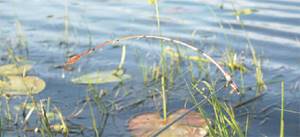
Active fishing for crucian carp with a jig
With the active method of summer fishing for crucian carp, the jig is constantly or most of the time in motion in accordance with the vibrations of the side nod spring.
In addition, the fisherman can change the position of the jig in the space of a summer pond in search of crucian carp in neighboring areas and at different fishing horizons.
The picture shows dull tin-lead jigs without crowns, which are better than others for actively catching crucian carp with a side nod in summer reservoirs without a current, which include ponds, lakes, oxbow lakes, etc.
The flattened shape allows the jig to glide smoothly between the stems of algae. The dull gray color of the baits practically does not differ from the silted bottom.
Due to the relatively small specific gravity, the jigs at the end of the active retrieve to the level of the bottom of the pond do not fall through the bottom slurry.
As mentioned above, the active method of catching crucian carp involves constantly repeating movements of the jig, which can be done when fishing in the summer with only one fishing rod. But the results of catching crucian carp with a gliding bait can be more impressive than with three passive gear.
Crucian carp are actively caught with a jig, usually using two types (or classes) of fishing rods: a telescopic or plug-in rod with a side nod of medium length, or a short side rod with a “straight” nod.
Closer to the middle of the hot summer, it is easier to find active crucian carp during the day in the depths of the pond, where the water is cooler.
In late autumn, they actively catch crucian carp with jigs, also in pits, but due to the fact that the water there becomes warmer than in the shallow coastal part of the reservoir. A temperature difference of only 1-2 degrees significantly affects the activity of crucian carp.
Lure
Bait for catching crucian carp in the spring with a side nod, as for other gear, at this time you need finely dispersed bait, with natural aromatics, without large food particles. If there are no small ruff, perch or roach in the reservoir, you can add food bloodworms to the mixture. Bait works well in the summer - to attract a flock and keep it in place.
In warm water, when there are a lot of large crucian carp, after spawning or in the summer, porridges made from millet, peas and pearl barley work well. In the summer we experiment with dips and flavors. In spring, you can’t feed a lot. We feed the fishing point a little.
When using search tactics, you can first walk or swim through the points and throw a walnut-sized lump of food into each one - perhaps this action will lure crucian carp standing nearby in the bushes into the window. In general, for nod fishing, the same recommendations for crucian carp bait apply as for other gear.
There is only one rule - in each specific reservoir, you need to select keys for crucian carp based on composition, aromatics and feeding tactics.
Article about spring bait for crucian carp:
https://rybafan.ru/rybalka/prikarmlivanie/prikormka-na-karasya-vesnoy
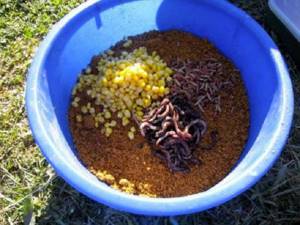
Jigs and attachments
The main element of bait is bait or bait. The jig essentially acts as a weighting agent. For roaches, the jig itself plays a much larger role. For crucian carp, the bait is more important. Many fishermen do not use jigs for this type of fishing - they place an ordinary lead shot above the hook.
In places where crucian carp is capricious, it is still better to use different jigs, depending on color and shape. You never know, maybe the crucian carp will be attracted to some specific bait, more from the point of view of the behavior of the bait under water when playing.
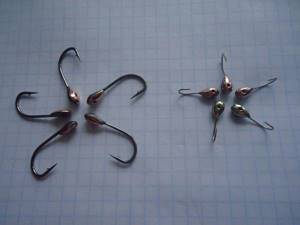
For crucian carp you don’t need the entire possible arsenal of jigs, as in winter. It is better to use the most ordinary balls, drops, boats, large ants, up to 8 grams, or special summer jigs for crucian carp - with a large hook.
Some use uralki, devils, goats, which are more suitable for baitless play, as well as additional pendants made of light jigs, plastic luminous ones (or simply a hook with bait, tied higher without a leash directly on the main line according to the drop-shot principle). There is no need for them to shine - dark, black tones are preferable.
In summer, crucian carp rarely take a reeler - it’s better to rely on the bait. Many fishermen make summer jigs for crucian carp with their own hands, soldering the hook into lead pellets or blanks with a crown. Read more about summer jigs.
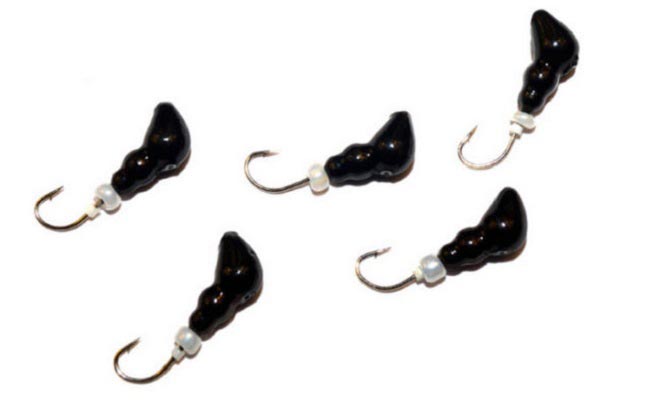
A worm is often put on the hook. In cold spring, bloodworms or maggots work better in clear water. With warming - corn, pearl barley. Choosing the right bait for crucian carp in the spring is a wide field for experimentation on any gear. The following baits can be attached to the jig:
- Red dung worm, crawler or underleaf.
- Maggot.
- Larva of dragonfly, caddisfly.
- Small fry 2-3 cm.
- Salo.
- Pieces of dog or cat food.
- Salo.
- Udder.
- A narrow strip of dark foam rubber, like a tail, dipped in dip.
- Bloodworm.
- Cereals - corn, peas, pearl barley, wheat, star pasta or horns.
- Semolina, mastyrka, bread crumb with halva, honey, vegetable oil, dough.
- Beads, pieces of rubber, polystyrene foam, artificial bloodworms or maggots, cookies and ottomans.
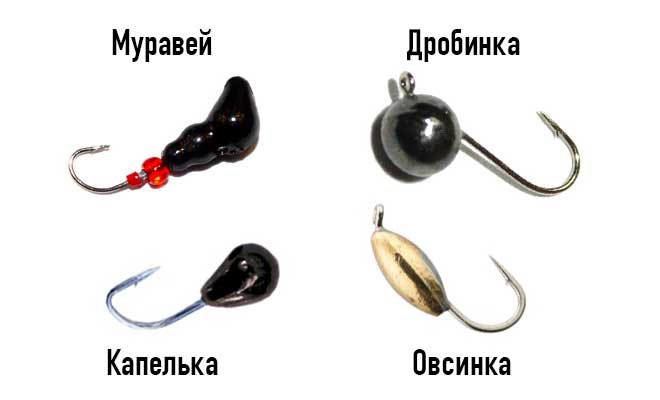
The classic bait is a bunch of worm. However, in some reservoirs the tastes of crucian carp are specific. You need to experiment not only with baits and methods of planting them, but also with aromatics. As dips and attractants, the crucian fisher should always have anise and garlic with him. This may also work:
- Fennel, cinnamon, dill, flax, hemp, vanilla, coriander, honey.
- Any industrial fishing dips.
- Valerian;
- Star ointment;
- WD-40 lubricant;
- Kerosene;
- Vegetable oils – hemp, flaxseed, sunflower.
We work with dips extremely carefully so as not to stain our hands and the bait. We dip only the baits to highlight them on the bait spot. You can add a little weak aromatics to complementary foods and only after finding out and confirming with bites that the crucian carp is attracted to this specific smell - otherwise you can spoil the point and scare away the fish.
